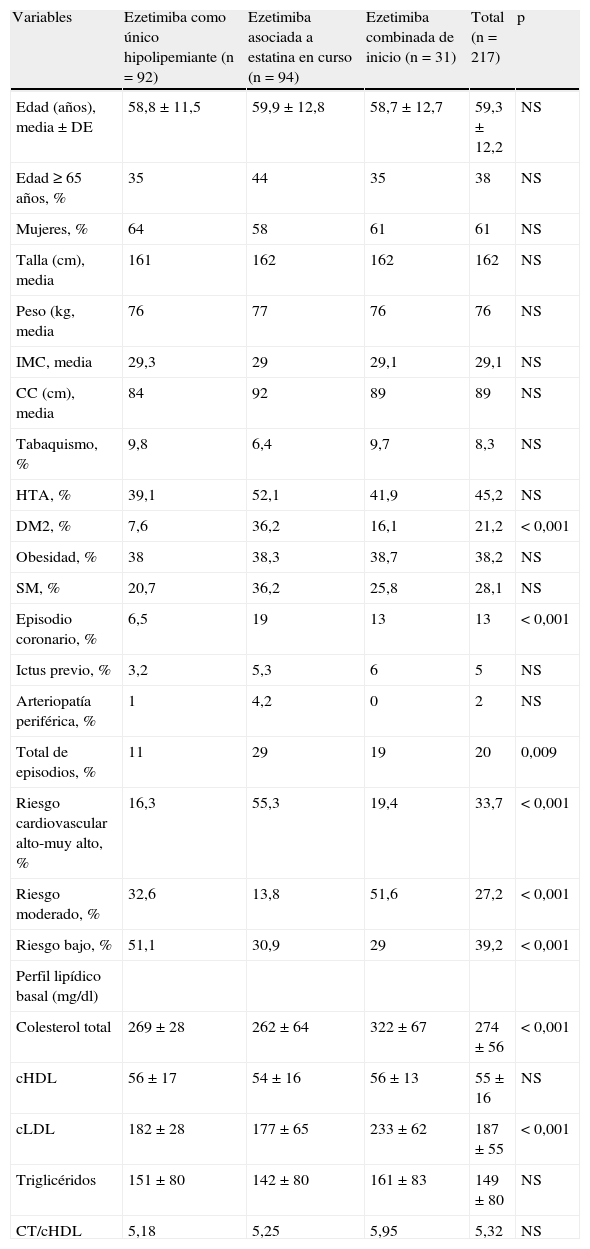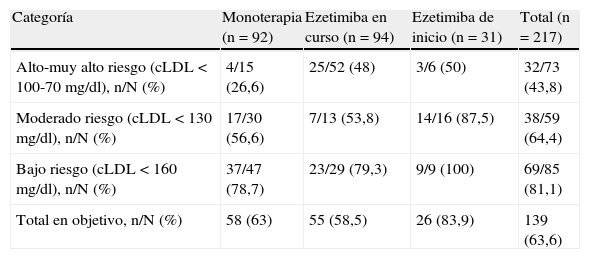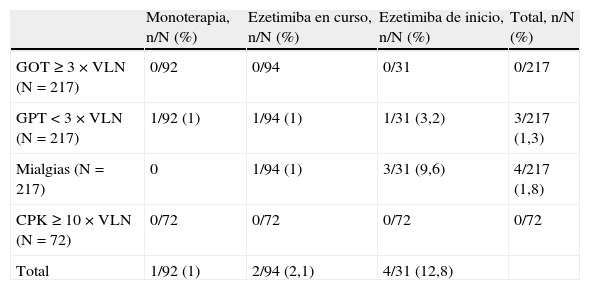Desconocemos la eficacia hipolipemiante y la seguridad de ezetimiba en monoterapia o combinada con estatinas en atención especializada y condiciones de práctica clínica.
Pacientes y métodosEstudio retrospectivo multicéntrico (unidades hospitalarias de medicina interna y endocrinología) de pacientes tratados con ezetimiba durante al menos 12 semanas. Los pacientes fueron incluidos en tres grupos: a) ezetimiba como único hipolipemiante; b) ezetimiba añadida a estatina, y c) ezetimiba combinada de inicio con estatina. La variable principal fue el porcentaje medio de reducción de colesterol de las lipoproteínas de baja densidad (cLDL) en el último análisis disponible respecto al documentado antes de comenzar el tratamiento con ezetimiba.
ResultadosIncluimos a 217 pacientes (media de edad, 59 años), 61% mujeres. Un 21% padecía diabetes mellitus tipo 2 y el 20% había sufrido un evento cardovascular previo, por lo que el tratamiento hipolipemiante debía satisfacerr objetivos de prevención secundaria. En el subgrupo de monoterapia (n=92; tratamiento medio, 41 semanas) el cLDL descendió un 28% (p<0,001). En el subgrupo de ezetimiba añadido a estatinas (n=94; tratamiento medio, 73 semanas) el cLDL disminuyó un 34% (p<0,001). En el subgrupo ezetimiba más estatina de inicio (n=31; tratamiento medio, 118 semanas) el cLDL descendió un 53% (p<0,001). En total, un 64% de los pacientes alcanzó el objetivo terapéutico propuesto por el Adult Treatment Panel III (ATPIII) para cLDL. En los pacientes con bajo riesgo (cLDL<160 mg/dl), riesgo moderado (cLDL<130 mg/dl) y riesgo alto-muy alto (cLDL<100-70 mg/dl), los enfermos en objetivo terapéutico fueron el 81%, el 64% y el 44%, respectivamente.
ConclusionesEn condiciones de práctica clínica habitual, ezetimiba resulta eficaz y segura para reducir el cLDL, permitiendo alcanzar los objetivos terapéuticos propuestos por ATPIII en un elevado número de pacientes, especialmente si se combina con estatinas.
This study was intended to assess the efficacy and safety of ezetimibe when taken alone or combined with statins in a specialized care setting and under standard clinical practice conditions.
Patients and methodsA multicenter, retrospective study in patients with dyslipidemia seen in a specialized outpatient clinic and treated with ezetimibe for at least 12weeks. Patients were divided into three groups: monotherapy, add-on ezetimibe, and initial coadministration.
ResultsA total of 217 patients (mean age 59years; 37% ≥65years) were enrolled. Of these, 61% were women, 21% had type 2 diabetes and 20% had had a previous cardiovascular event so that the lipid lower drug treatment should satisfy the objectives of secondary prevention. Mean change in the monotherapy group (n=92; mean 41weeks) included: decrease of LDLc of 28% (P<.001). In the group where ezetimibe was added on to different ongoing statins (n=94, mean 73weeks), mean changes was as follows: LDLc –34%, significant change as compared to monotherapy (P<.001). In the group with initial coadministration of ezetimibe with different statins (n=31; mean 118weeks), mean change included: LDLc –53% (P<.001). Overall, 64% of patients reached the thereapeutic objective proposed for the Adult Treatment Panel III (ATPIII) for cLDL. In patients with low risk (LDLc<160mg/dL), moderate risk (LDLc<130mg/dL) and high-very high risk (LDLc<100-70mg/dL), the percentage of patients who reached the therapeutic objective was 81%, 64% and 44%, respectively.
ConclusionsUnder standard clinical practice conditions, ezetimibe appears to be effective and safe for the control LDLc, thus making it possible to reach the therapeutic objectives proposed by the ATP-III in a high number of patients, especially when associated to statins.
Article
Diríjase desde aquí a la web de la >>>FESEMI<<< e inicie sesión mediante el formulario que se encuentra en la barra superior, pulsando sobre el candado.

Una vez autentificado, en la misma web de FESEMI, en el menú superior, elija la opción deseada.

>>>FESEMI<<<









